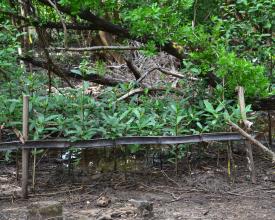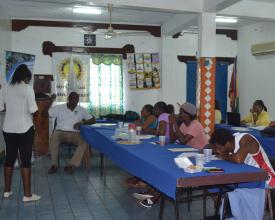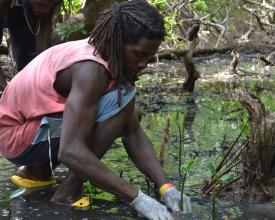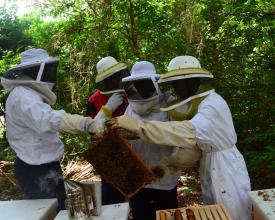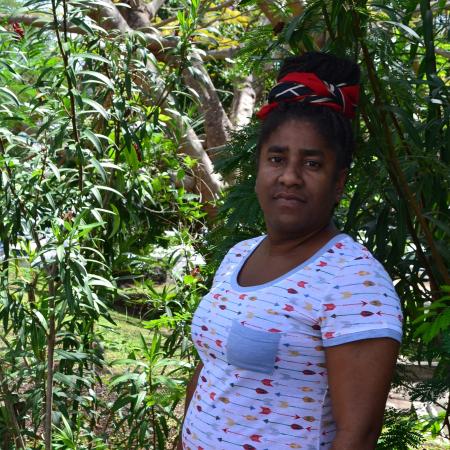
Restoration and Community Co-Management of Mangroves (RECCOMM)
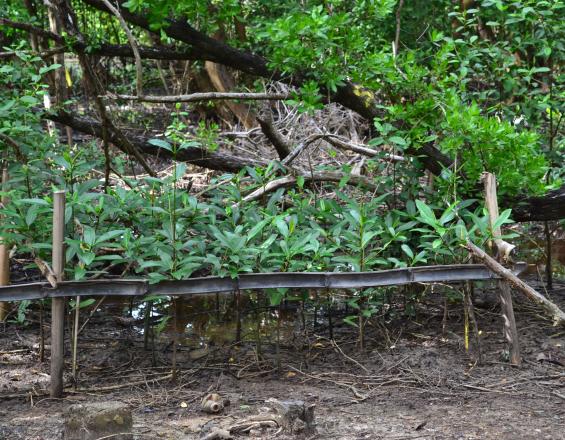
The solution aims at increasing the health of the mangrove and associated ecosystems and reducing vulnerabilities of coastal communities to climate change. It focuses on ecosystem restoration and local capacity building for habitat conservation and increased socio-economic benefits.
Technical components:
- Replanting of mangroves
- Sustainable mangrove management, including cultivation of fast growing alternative species
- Introduction of beekeeping as a sustainable alternative livelihood
- Promotion of ecotourism
Contexto
Défis à relever
As a small island in the south-eastern Caribbean Sea, Grenada is particularly vulnerable to the adverse effects of climate change. Extreme events such as hurricanes are likely to become more intense in the future. Two prolonged dry spells with devastating consequences to the agriculture sector occurred in the past five years.
The coastal communities in the project area are highly vulnerable to the adverse effects of climate change such as storm surges and sea level rise. They are also some of the most impoverished communities on the island. The project area is experiencing heavy coastal erosion, partially due to past sand mining activities. The mangroves that act as a natural defence are being reduced by deforestation and unsustainable harvesting practices to produce charcoal.
Ubicación
Procesar
Summary of the process
The project approach includes technical as well as institutional capacity building and support. Institutional capacity building, in particular through the establishment of a co-management structure (Building Block 1), forms the basis for a successful intervention. Technical measures focus on mangrove restoration and local capacity building for habitat conservation (Building Block 2). In order to reduce the pressure on the mangrove ecosystem and create more resilient livelihoods for local communities, the project also includes income generating activities such as apiculture (beekeeping) development (Building Block 3).
Building Blocks
Establishment of a co-management structure
To build institutional capacity and support implementation and future replication on national level, a co-management structure was established: the Northern Telescope Mangrove Management Board (NTMMB). This ensures that the community joins hands with government officials to manage the project, and also helps to enforce mangrove protection policies in Telescope.
Community ownership of the project is ensured, while the highly-constrained government staff resources are supplemented, thereby supporting long term protection of the mangroves.
NTMMB is comprised of five members from the local community and one member from the St. Andrew Development Organisation (SADO), as well as members from the Ministry of Tourism and Culture and three Divisions of the MoALFF (Agriculture, Lands, Forestry, and Fisheries), and the Environment division of the Ministry of Education, Human Resource Development, and the Environment. Monthly board meetings are held.
Enabling factors
The community members of the NTMMB have received training regarding establishing and operation of a community based organization. Since Co-Management means a joint board with government and authorities, also technical capacity building was important, including on mangrove planting, management and monitoring.
Lesson learned
Well established entities are needed for the development of a co-management component. There ought to be clear guidelines, set beforehand, which speak directly to what would be expected of the entities involved in the co-management process. These guidelines should indicate which parties are responsible for certain areas regarding the management of the area, public relations to monitoring to leveraging funds. Given that the community representatives are interacting with the area more frequently than the government representatives, there should be a regular reporting mechanism. This would provide an effective communication channel through which all parties are aware of actions regarding the project area.
In the event that there are no existing bodies for the establishment of a co-management structure, capacity development efforts need to be explored for the potential creation of the required entities.
Mangrove forest and coastal revegetation
The natural mangrove forest and coastal vegetation of the project area have been severely degraded over the past years due to the unsustainable use of members of the community paired with the adverse impact of aspects of climate change. This degradation therefore increased the coastal communities vulnerability to the impacts of climate change such as hurricanes, storm surges, and coastal flooding. Additionally, coastal (non-mangrove) vegetation were scant which decreased the stability of the shore area (beach).
The replanting of mangrove species improves the health of the mangrove area and its ecosystem services with respect to coastal protection as well as habitat provision for various flora and fauna.
Enabling factors
As non-mangrove but salt tolerant species are necessary for overall beach stability and health of the coastal area, having a source of (preferably local) species to use for revegetation is critical. This requires the support of agencies/NGOs that can provide the relevant support. There is also a need for capacity development for community members on the process of revegetation. They are then able to continue the process on their own, thus leading to the long-term sustainability of the measures.
Lesson learned
With the restoration/replanting of vegetation, it is important to have a working knowledge of the dynamics of the surrounding environment. Potential losses due to wave action need to be considered, along with the possibilities of little to no loss if plants are less exposed to wave ore erosion effects of the sea. The highest vegetation loss occurred in sections of the mangrove forest that was nearest to the shore where the high wave energy resulted in a 100% loss of the seedlings. In contrast, those that were planted further away from the shore showed over 90% successful growth. For replication purposes, if a decision is made to revegetate the shoreline area, the seedlings ought to be planted in material such as bamboo which may be sturdy enough to withstand the wave energy. Additionally, community awareness is crucial so that the accidental destruction of the plants are limited.
Apiculture development
One of the main threats to the area in question is degradation as a result of the cutting of mangrove trees to use for income generating purposes. Apiculture was introduced as an alternative livelihood which will enable the members of the community to use the resources of the mangroves without damning it, thus leaving the mangrove forest intact.
Additionally, the establishment of bee hives in the area will benefit farmers in the surrounding area. Not only will the bees assist with the pollination and ultimate health of the mangrove forest, they will assist with the pollination of crops on farms in the surrounding area. Through this, other community members can indirectly benefit from the introduction of apiculture as an alternative livelihood.
Enabling factors
A number of community members were trained in various aspects of beekeeping. From tending to the hives, bee diseases and pests to harvesting honey. These trainings were facilitated through collaboration with tertiary education institutions as well as the Agriculture Division. This enabled the RECCOMM project to utilise capacity that is already available in country and share that capacity/knowledge with the local community.
Lesson learned
Given that apiculture does not provide immediate income, the persons involved need to be committed to the task. A wide net needs to be cast to attract the interests of individuals and the process needs to be clear from the onset. This will allow the potential participants to have a clear picture of what would be expected in order for them to succeed at their new livelihood. A venture such as this would require the full support of a committed core group of people to reduce the chances of the group dwindling. The training should also not just involve technical capacities, but also managerial and marketing skills. This will prepare the new beekeepers for the sale and distribution of their product.
Impacts
- A biological and socio-economic baseline study of the project area was completed, consisting of beach profiling, soil sampling, community surveys and the selection of different implementation sites.
- Community consultations and meetings were held to inform and involve the community in the project. This resulted in high interest in the mangrove replanting/protection components, and in the project’s sustainable livelihoods components (beekeeping, sustainable charcoal management,ecotourism).
- Over 1900 mangrove seedlings, as well as other species such as neem, almond, and sea-grape, were planted at the project site between 11/2015 and 11/2016. They are continuously monitored by members of the community. The planted transects have been fitted with basic fences to improve their visibility to the users of the mangrove.
- Courses on beekeeping provided participants with skills to operate as professional beekeepers. Hives were placed close to the project site, equipment was procured and the beekeepers were supported to establish a cooperative.
- Specifications and designs for a boardwalk and a bird-hide to support eco-tourism activities have been developed. Training in eco-tourism will soon begin.
- Awareness activities, conducted during the implementation of other activities such as mangrove planting, have targeted the broader public to inform them about the project.
Beneficiaries
- Northern Telescope Mangrove Management Board (NTMMB)
- Coastal communities, in particular charcoal producers, beekeepers, ecotourism guides, schools
- Tourism sector
- Farmers in the Telescope community
Sustainable Development Goals
Story

Heidi Knights has lived in Telescope for the past 12 years, and along with the other members of the Telescope, has notice the progressive decline in their surrounding environment. For generations the community has used the mangroves and coastal area for cultural, recreational, and domestic purposes. Some members of the community cut mangrove trees to produce charcoal which is then sold and used as fuel. There are also farmers in the community who use sticks from mangrove trees as support for their crops.
Telescope residents did not know exactly how else they could have used the area without harming it. Even while they were using the mangrove forest as a source of income, they never realised that they can continue using it as a more sustainable source of income while leaving it intact.
Since becoming involved with the RECCOMM project and participating in various activities: from replanting of mangroves seedling and non-mangrove plants, to trainings for capacity development and beekeeping, Heidi and other community members have since developed an ownership of the mangroves. They are now engaged in active monitoring of the seedlings they’ve planted and are excited to begin harvesting honey from their beehives. Heidi believes that with continued work and more outreach and awareness activities, more communities can be involved in protecting their environment and Telescope.
